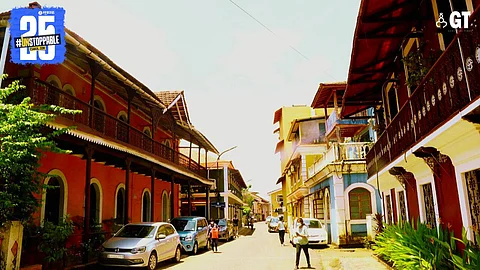

As you drive down the winding narrow streets – flanked by an assortment of cubbyhole stalls – of Baga, in Goa, you get a faint feeling of being in Rishikesh or Haridwar, or, for that matter, in any Indian small town street bazaar.
It lacks symmetry, with blaring bright-coloured hoardings, haphazardly parked scooters and bikes, glaring white lights, litter strewn around and chaos reigning supreme. It makes you wonder whether you’re really in Goa.
A transformative change is unfolding in many parts of the coastal State, altering its very character. Idyllically charming Indo-Portuguese houses are being torn down, paddy fields mowed and hillocks carved out to cram as many commercial projects as possible into these spaces.
It’s being done with no sense of aesthetics or town planning. The way these areas are being developed, you get a sense that the town planning authorities are in a tearing rush to rake in huge revenue (and alleged underhand private deals for themselves, too), with little or no care for Goa’s distinct topography.
A transformative change is unfolding in many parts of the coastal State, altering its very character.
The Oxford dictionary defines town planning as: “The planning and control of the construction, growth, and development of a town or other urban area”.
Goa’s Town and Country Planning (TCP) Department seems clueless about 'planning and control' in this concept, or chooses to flagrantly ignore these two elements of town planning.
And thus, we are witnessing unplanned and uncontrolled development across Goa, like in most parts of the country.
If you were to throw back your glance at Goa’s history of town planning, there are rich evidences of flawless town planning blueprints, complete with modular pathways, gates, market places, bridges, parks, fountains, administrative quarters, hospitals and other such paraphernalia.
One of them is the beautifully laid out neighbourhood of Campal de Dom Manuel, named after the Portuguese viceroy Dom Manuel de Castro (1826-1835), who is also known as the ‘Father of Panjim’.
This part of Panaji (Panjim before Liberation) was built on reclaimed land almost two centuries back, and is testament to the faultless planning of that era.
The shaded locality has neatly built structures with a serene garden and modular pathways.
If you were to throw back your glance at Goa’s history of town planning, there are rich evidences of flawless town planning blueprints, complete with modular pathways, gates, market places, bridges, parks, fountains, administrative quarters, hospitals and other such paraphernalia.
Fontainhas and Sao Tome are other parts of Panjim that give a glimpse of proficient town planning of the Portuguese era. One can get a feel of the Portuguese-era town planning sensibilities as you walk through the picturesque streets of the old Latin Quarter in the Fontainhas area of Panjim.
Today, many of these houses in the area have been converted into cafes, fine-dining eateries, boutiques and lodges.
Its redevelopment has been done taking conservation into consideration. It stands out in the mess of Panjim’s Smart City like an oasis of soothing old Goan charm. Fontainhas brilliantly coalesces vintage and modern.
On the west of the Portuguese-era locality is a neighbourhood called Altinho (meaning tall or high in Portuguese) on hillocks overlooking the city. Houses, here, were once the abode of the elite. It still is.
Today’s town planners can take a page from Altinho’s planning, which retains the natural topography of the place.
It does not brutally slash through hills or chop down trees. Its roads climb up or slope down. At many places, there are steps that take you to a higher level. Why can’t we still have such features? Why have we abandoned them?
Goa’s Town and Country Planning Act, 1974 does not adequately cover the aspect of conservation of heritage homes and areas. These laws severely fall short in effectively preserving the heritage homes and areas of Goa.
Goa’s Town and Country Planning Act, 1974 does not adequately cover the aspect of conservation of heritage homes and areas. Article 51 A (F) of the Constitution of India states: “It shall be the duty of every citizen of India to value and preserve the rich heritage of our composite culture”.
These laws severely fall short in effectively preserving the heritage homes and areas of Goa.
In the absence of any motivation or incentive, Goa’s ubiquitous Indo-Portuguese styled homes are fast vanishing, giving way to unimaginative swanky buildings, making no concession to the environment or the topography around them.